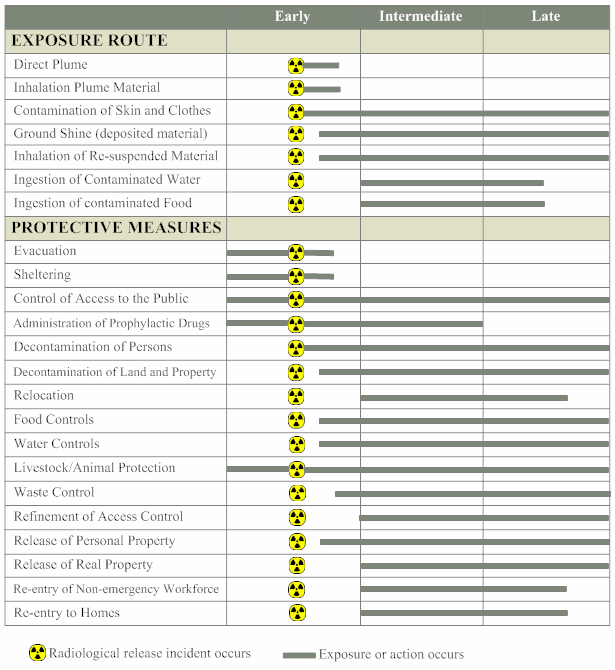Three Phases of the Response to an RDD or IND
- Diagram of Time Phases of a Response and Associated Activities
- General Comments
- Early Phase (Emergency Phase)
- Intermediate Phase
- Late Phase
Diagram of Time Phases of a Response and Associated Activities
Relationship Between Exposure Routes, Protective Measures, and Time Frames for Effects

- For some activities, the figure indicates that protective actions may be taken before a release occurs. This would be the case if authorities have prior warning about a potential RDD/IND incident.
- In certain circumstances, food and water interdiction may occur in early phases. In addition, some exposure routes (e.g., ingestion of contaminated food) may occur earlier than depicted in the figure, depending on the unique characteristics of the incident.
Adapted from Planning Guidance for Protection and Recovery Following Radiological Dispersal Device (RDD) and Improvised Nuclear Device (IND) Incidents (PDF - 519 KB) (DHS/FEMA, published in Federal Register, August 1, 2008, Z-RIN 1660-ZA02)
General Comments
- Common to all radiation incidents, but will be very incident specific
- Represent a generic framework for structuring responses.
- Cannot be represented by precise time periods, and periods may overlap
Early Phase (Emergency Phase)
- Time period
- Hours to a few days post event, depending on incident
- Response during early phase
- Protective action decisions for RDD/IND will be made with only preliminary radiation measurement data or on the basis of pre-existing models.
- Actions should be taken quickly and modified as needed, when additional data become available.
- Examples of possible early phase protective actions
- Shelter-in-place vs. evacuation
- Administration of medical countermeasures (e.g., stable iodine)
- Decontamination
- Access control
- Victim extraction
- Considerations include
- Location of high dose radiation areas
- Exposure to radioactive plume
- Short-term exposure to deposited radioactive materials (fallout)
- Inhalation of radioactive material
Intermediate Phase
- Time period
- May follow early phase within a few hours, as some intermediate phase decisions will need to be made within a few hours post event
- After incident source and releases brought under control, and protective action recommendations can be made based on measurements of exposure and on identification of deposited radioactive materials
- Activities typically overlap with early and late phase activities.
- May continue for weeks to many months until protective actions can be terminated
- Response during intermediate phase
- Actions focused on return of key infrastructure and services and rapid return to normal activity
- Examples of possible intermediate phase protective actions
- How/when to reopen critical infrastructure (e.g., transportation systems, hospitals, businesses, residences, parks)
- How/whether to allow use or release of real and personal property (cars, clothing, equipment) impacted by the incident
- Food and drinking water interdiction
- Relocation of the population versus allowing the public to return home and providing assurances that residential and commercial properties do not represent a significant risk to health
- Need to consider late phase response objectives during intermediate phase
- Planning for long-term site clean-up and remediation begins
Late Phase
- Time period
- Planning begins during intermediate phase and extends post event until remediation is completed
- Response during late phase
- Actions no longer represent a response to "emergency situation"
- Action objectives include cleanup and site recovery, work of reducing environmental radiation levels to acceptable levels
- Phase ends when all remediation actions have been completed

